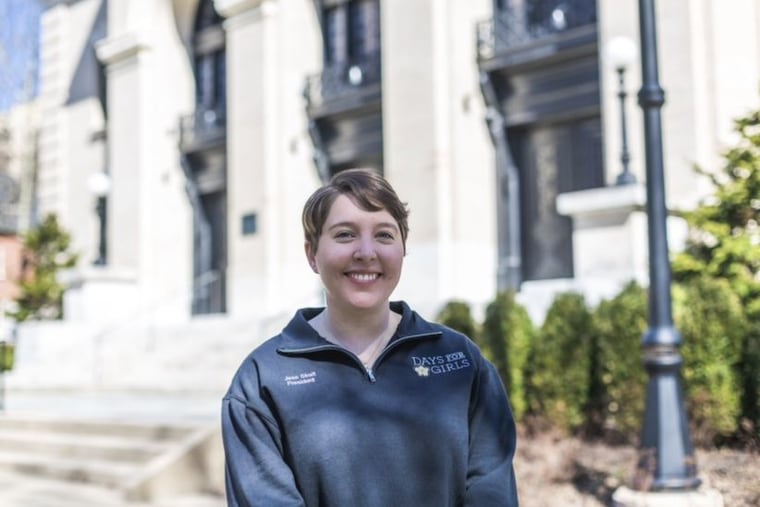These Penn State students are tackling the issue of period poverty on their own campus
A campus-wide survey found 13% of students who menstruate have skipped class or work because they didn’t have access to period products at Penn State.

Last fall, when Jess Strait became president of a Penn State club focused on eliminating stigma associated with menstruation, one of her goals was to find out how period poverty — the inability to afford sanitary products — was affecting her fellow classmates.
Inspired by the work of No More Secrets, a Mount Airy nonprofit that delivers menstrual care packages around Philadelphia, Strait, a 20-year-old rising senior, and her team at the Days for Girls club drafted a short survey of 10 open-ended questions about menstruation. What they found shocked them.
Of the approximately 500 students surveyed, 13% have skipped class or work because they didn’t have the products they need.
If you apply that rate to the entire student body, Strait said, “that should be at least 2,500 undergraduates who are missing classes and not getting the most of their education because they don’t have period products.”
In the fall, the club distributed nearly 1,000 menstrual cups for free on campus. Aside from donation drives, members have met on Zoom for most of the last year. They are slowly transitioning back to in-person meetings as more members become vaccinated.
The push to eliminate period poverty has been led by college students all across the country.
A study by researchers at George Mason University’s College of Health and Human Services published in February found that one in 10 college students who menstruate reported chronic period poverty, which means that they struggled to pay for basic products each month. And 14% had trouble paying for menstrual products within the last year.
The cost of period products can add up quickly. A 2019 survey of 2,000 respondents commissioned by INTIMINA, a menstrual cup company, found that on average, a woman spends $13.25 per month on menstrual products — or $6,360 in an average woman’s lifetime. For young women in their 20s, the monthly cost of having a period may be even higher due to heavier flows from irregular periods and maturing hormone systems.
Students who identified as Black, Latina, from immigrant backgrounds, or the first in their families to attend college were more likely to experience period poverty, the study found. Those who could not afford period products were also more likely to experience higher rates of moderate or severe depression — between 61% and 68% — compared to the 43% of those who reported moderate or severe depression who did not experience period poverty.
At Penn State, the Days for Girls club conducted their own survey of more than 500 students who menstruate. They found that 49% of respondents have started their periods on campus outside of their residence halls and been unable to find products. (In that situation, students reported using toilet paper as a makeshift pad, asking friends or strangers for a product, or skipped class to go home early.)
The survey also found 12% of respondents reported they couldn’t afford period products. Over a third of students surveyed also reported being unable to properly dispose of used products in an on-campus bathroom, and two-thirds of respondents said they did not know of any way to get free products on campus.
Strait said the group is working with the university to address the issue of disposal in on-campus bathrooms.
» READ MORE: Period products should be free in public bathrooms | Opinion
“That was something that had been under our radar before this semester,” she said. “In the free response questions we had several students who don’t identify as women and sometimes in their bathrooms there wasn’t a trash can, at all. They might have to carry a product with them to dispose of later. The fact that those communities are kind of being put at risk … was really alarming to us.”
Compared to other Big Ten universities, Penn State falls somewhere “in the middle, towards the end of the pack” when it comes to menstrual equity, said Emma Cihanowyz, the club’s vice president of advocacy. On one end of the spectrum, Indiana University offers free period products in all highly trafficked women’s, men’s, and gender neutral bathrooms, while on the other end, the University of Maryland offers free products only in the student union and at the University Health Center.
“A lot of universities have the same goals as we do currently, which is to expand free product access all across campus,” said Cihanowyz, a 19-year-old rising junior. “Moving forward, our advocacy team is going to prioritize product access on campus. We want to drop that 13% as close to zero as far as we can.”
Strait said the club plans to speak with the university’s new director of health services in the fall to explore how they can meet that goal, and to continue education efforts on campus about how to access and dispose properly of menstrual products.
“I think we’re assuming that people know things that we shouldn’t necessarily be assuming,” she said. “And we’re working on being the most educated group ourselves so we can then disseminate the proper information to our students.”